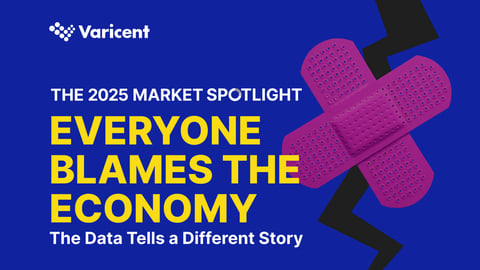In the fast-paced world of revenue generation, Chief Revenue Officers (CROs) find themselves at the helm of a ship navigating through constant change. This blog serves as a guide, providing CROs with profound insights into the dynamic realm of adaptive compensation strategies to steer their organizations toward unprecedented success.
This guide highlights:
Embracing Change in the Go-To-Market Landscape
The contemporary business landscape demands a profound shift in the approach to Go-To-Market (GTM) strategies. CROs are urged to embrace change as an opportunity rather than a hurdle. As market dynamics evolve at an unprecedented pace, CROs are tasked with not only responding to change but proactively shaping strategies that can withstand the test of volatility.
In this dynamic environment, the traditional approach to compensation plans no longer suffices. Instead, CROs must adopt a continuous and adaptive approach to align compensation strategies with the ever-evolving GTM strategies. This entails more than just reacting to market shifts, it requires anticipating and preparing for them. They must ensure that compensation plans remain agile and responsive to changing market demands.
Recognizing change as a driving force, we must emphasize the importance of a dynamic GTM approach that necessitates a similarly agile compensation strategy. By embracing change and aligning compensation plans with GTM strategies, CROs can position their organizations for success in an increasingly competitive and rapidly changing marketplace.
The Role of AI in Shaping Sales Compensation Strategies
In today's hyper-connected and data-driven world, the role of artificial intelligence (AI) in shaping sales compensation strategies cannot be overstated. AI has emerged as a transformative force, empowering CROs to make data-driven decisions and optimize their compensation plans with unprecedented precision and insight.
AI-driven insights provide CROs with a deeper understanding of market trends, seller behaviors, and performance metrics. By harnessing the power of AI, CROs can analyze vast amounts of data in real-time, uncovering valuable patterns and correlations that would be otherwise impossible to detect. This allows CROs to make informed decisions that resonate with the organization's overarching goals, driving revenue growth and maximizing ROI.
Moreover, the infusion of AI into compensation strategies represents a paradigm shift in how CROs approach their roles. No longer reliant solely on intuition or historical data, CROs can leverage AI to anticipate trends, identify opportunities, and mitigate risks with unparalleled accuracy and efficiency. This strategic use of AI not only enhances the effectiveness of compensation plans but also positions CROs as visionary leaders capable of navigating the complexities of the modern business landscape.
In this section, we dive into the practical applications of AI in shaping sales compensation strategies. From predictive analytics to machine learning algorithms, AI technologies can be leveraged to optimize incentive structures, drive seller performance, and align compensation plans with strategic objectives. By highlighting real-world examples and best practices, there is transformative potential of AI in revolutionizing the way CROs approach revenue generation.
As CROs embrace AI-driven insights, they gain a strategic advantage in the competitive marketplace. By harnessing the power of AI to inform their compensation strategies, CROs can unlock new opportunities, mitigate risks, and drive sustainable growth in an increasingly digital and dynamic business environment.
Bridging the Gap: Dynamic Compensation Plans for Aligning Seller Behaviours
In the fast-paced world of revenue generation, CROs recognize the imperative of designing dynamic compensation plans that align seamlessly with strategic objectives while also shaping seller behaviors for optimal performance.
Dynamic compensation plans are not static documents but living strategies, capable of evolving in tandem with the business landscape. As architects of incentive structures, CROs must ensure that these plans flex and adapt to changing market conditions and organizational priorities. This requires a nuanced approach that translates strategic goals into actionable plans, ensuring that every incentive contributes significantly to the organization's forward momentum.
Central to this approach is the concept of aligning seller behaviors with organizational goals. Compensation plans become more than just monetary tools; they serve as instruments to motivate, inspire, and guide behaviors that drive success. By fostering a culture where individual actions harmonize with the collective goals of the organization, CROs can create a high-performing sales force that is fully aligned with the company's strategic objectives.
Navigating through the process of designing and implementing dynamic compensation plans that effectively align seller behaviors with organizational goals, there are intricacies of creating incentive structures that not only incentivize desired behaviors but also adapt to changes in the business landscape. Dynamic compensation plans can drive performance, foster innovation, and propel the organization towards its revenue targets.
By embracing dynamic compensation plans and aligning seller behaviors, CROs can bridge the gap between strategy and execution, driving sustainable growth and success in an ever-evolving market.
Maximizing Impact with Diverse Compensation Structures
Traditional compensation models in revenue generation often extend beyond base salaries and commissions to include additional forms of incentives like spiffs, contests, and one-off payments. While integrating these diverse compensation structures can yield significant benefits, it requires careful consideration.
Spiffs offer immediate rewards for specific actions, driving short-term focus and urgency. Contests inject excitement and competition, fostering camaraderie and rallying teams around common goals. One-off payments recognize exceptional achievements or unexpected wins, providing motivation beyond regular commission structures.
However, over-reliance on these non-traditional compensation structures may lead to short-sighted focus and detract from long-term strategic objectives. Excessive use of one-off payments can create expectations for inconsistent or unpredictable compensation, undermining the stability of the compensation plan.
To maximize the impact of diverse compensation structures, CROs must strike a balance between short-term incentives and long-term goals. Clear communication and alignment with organizational objectives are essential to ensure that these incentives drive desired behaviors without compromising the overall strategy.
Integrating diverse compensation structures can add depth and flexibility to incentive programs, motivating sales teams and driving performance. Careful consideration and strategic alignment are necessary to mitigate risks and maximize the benefits within the broader compensation strategy.
Embracing Dynamic Compensation Strategies for Agile Adaptation
Static compensation plans are no longer sufficient to drive optimal performance. CROs must embrace dynamic compensation strategies that evolve in real-time to reflect shifting priorities and market dynamics. Rather than rigidly adhering to annual compensation structures, CROs are encouraged to adopt a more agile approach, continuously assessing and adjusting incentive programs throughout the year. See how you can empower your teams with real-time data to build dynamic compensation strategies by taking an interactive product tour.
By leveraging real-time data insights and feedback loops, CROs can identify performance trends, address inefficiencies, and capitalize on emerging opportunities with agility and precision. This dynamic approach not only maximizes the effectiveness of compensation plans but also fosters a culture of adaptability and innovation within the sales organization.
The Revenue Generation Frontier
In a landscape where revenue generation is the ultimate frontier, CROs are not merely navigators; they are leaders charting new territories. CROs must be empowered with the tools and insights needed to navigate the complexities of modern revenue generation successfully. From embracing change in the dynamic GTM landscape to harnessing the power of AI-driven insights and designing dynamic compensation plans, CROs must be equipped to lead with agility and innovation.
By aligning seller behaviors with organizational goals and maximizing the impact of diverse compensation structures, CROs can drive sustainable growth and success. Embracing dynamic compensation strategies allows them to adapt swiftly to evolving market dynamics, ensuring that their organizations remain agile and competitive.
As CROs embark on this journey to unlock the full potential of revenue generation, they become catalysts for change, driving innovation and growth. By embracing the Revenue Generation Frontier and leveraging insights in this guide, CROs can propel their organizations to new heights of success in an era where adaptability is paramount.




